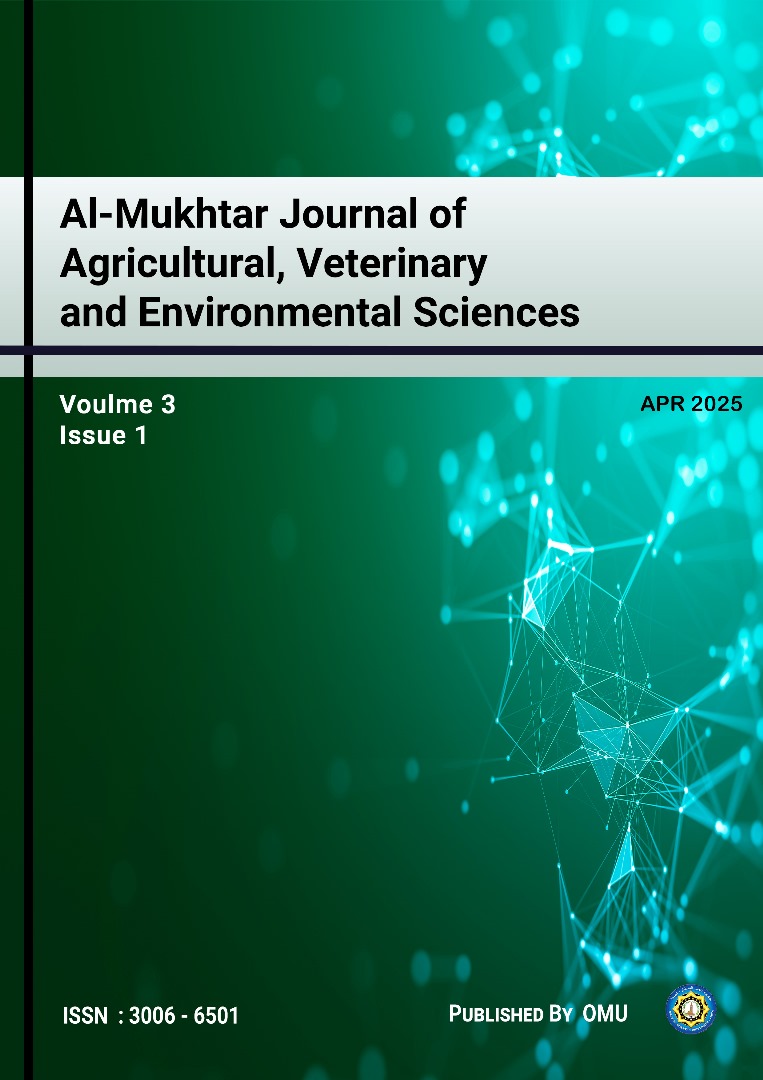The Effect of Babesia on Some Blood Parameters in Camels (Camelusdromedarius) Inthenortheastern of Libya
DOI:
https://doi.org/10.54172/0ahcck11Keywords:
Babesia, Hematolog, Protozoa, Piroplasma, Camels, North-Eastern, LibyaAbstract
The study involved 160 camels raised in northeastern Libya from 2021–2022. Blood samples were randomly collected from each camel's jugular veins and sent to a laboratory for hematological and parasitological examination. The results showed that 35% of the samples were infected with Babesia species. High infection rates were found in Tubrug-khuayri (70%), Ajdubiya-road (60.6%), Alhamamuh (60%), Sulanta (46.6%), and Alqabah (28.4%). Lower infection were observed in Qanduluh (19.35%) and Imsaeid (7.1%). Babesia spp in Camels penetrate erythrocytes at the sporozoite stage, appearing as reddish violet particles inside blood cells. The study also showed that 56 camel blood samples were infected by babesiosis, with complete blood count examination revealing a deficiency in RBCs (5.43±2.33), and increase in WBCs (14.63±8.23), MCV (52.8±36.8), (22.11±9.45). MCH and MCHC (47.4±19.8). Significant differences were observed (p<0.05). Additionally , there was an increase in white blood cells types including neutrphilia (51.95±1.23), lymphocytes 40.30±1.23) and monocytes 5.51±0.35). in conclusion The study found a 35% prevalence of Babesiosis in camels, leading to decreased red blood cell count but increased leukocytes, neutrophils, lymphocytes, and monocytes, causing lysis and hematopoietic system depression.
References
Aajep, M. A. M. O. (2020). Prevalence and Risk factors of Trypanosoma evansi Infections and Classification of Its Vectors in Camel in Tamboul Locality-Gezira State-Sudan. Sudan Uni-versity of Science & Technology.
Abd-Elmaleck, B. S., Abed, G. H., & Mandourt, A. (2014). Some protozoan parasites infecting blood of camels (Camelus dromedarius) at Assiut locality, Upper Egypt. J. Bacteriol. Para-sitol, 5(2), 1-6.
Al-Amery, A., Faraj, A., & Majeed, S. (2017). Detection of Haemoprotozoa in camels in Al-Najafprovince, Iraq. Int. J. Adv. Biol. Res, 7(2), 238-241.
Al-mialy, A. J., Hatem, A. A., & AL-Abedi, A. H. J. (2018). Some epidemiological aspects of Piro-plasmosis of sheep and camels in desert of Al-Najaf. Kufa Journal For Veterinary Medical Sciences, 9(2), 1-7.
Al-Naily, Z. H. C., & Jasim, G. A. (2018). Molecular study of Babesia spp and Theileria spp in camels of Al-Diwaniyah province in Iraq. Kufa Journal For Veterinary Medical Sciences, 9(2), 62-70.
Alsaad, K. M., Al-Amery, M., Al-Hamed, T., & Muhsen, R. K. (2015). Babesiosis caballi in one humped dromedaries of Basrah province. Basrah Journal of Veterinary Research, 14(2), 207-214.
Egbe-Nwiyi, T. (1994). Haematological and pathological studies of camel babesiosis in Nigeria. Bulletin of animal health and production in Africa.
El-Naga, T. R. A., & Barghash, S. (2016). Blood parasites in camels (Camelus dromedarius) in Northern West Coast of Egypt. J. Bacteriol. Parasitol, 7(1), 258.
Farhan, B., & Hameed, M. (2017). PREVALENCE OF BABESIA, THEILERIA AND EVALU-ATED OF SOME BLOOD PARAMETERS IN CAMELS IN AL NAJAF PROVINCE. International Journal of Science and Nature, 8(3), 561-564.
Ibrahim, A. M., Kadle, A. A., & Nyingilili, H. S. (2017). Microscopic and molecular detection of camel piroplasmosis in Gadarif State, Sudan. Veterinary Medicine International, 2017.
Jasim, H. J., Azzal, G. Y., & Othman, R. M. (2015). Conventional and molecular detection of Babesia caballi and Theileria equi parasites in infected camels in south of Iraq. Basrah Journal ofVeterinary Research, 14(2), 110-121.
Kalani, H., Fakhar, M., & Pagheh, A. (2012). An overview on present situation babesiosis and theileriosis and their distribution of ticks in Iran. Iranian Journal of Medical Microbiology, 5(4), 59-71.
Khamesipour, F., Doosti, A., Koohi, A., Chehelgerdi, M., Mokhtari-Farsani, A., & Chengula, A. A. (2015). Determination of the presence of Babesia species in blood samples of cattle, camel and sheep in Iran by PCR. Archives of Biological Sciences, 67(1), 83-90.
Mirahmadi, H., Ghaderi, A., Barani, S., Alijani, E., Mehravaran, A., & Shafiei, R. (2022). Preva-lence of camel babesiosis in southeast of Iran. Veterinary Medicine and Science, 8(1), 343-348.
Ord, R. L., & Lobo, C. A. (2015). Human babesiosis: Pathogens, prevalence, diagnosis, and treat-ment. Current clinical microbiology reports, 2, 173-181.
Selmi, R., Dhibi, M., Ben Said, M., Ben Yahia, H., Abdelaali, H., Ameur, H., . . . Mhadhbi, M. (2019). Evidence of natural infections with Trypanosoma, Anaplasma and Babesia spp. in military livestock from Tunisia. Trop. Biomed, 36(3), 742-757.
Swelum, A. A., Ismael, A. B., Khalaf, A. F., & Abouheif, M. A. (2014). Clinical and laboratory findings associated with naturally occurring babesiosis in dromedary camels. Journal of Veterinary Research, 58(2), 229-233.
TAKTAZ-HAFSHEJANI, T., & KHAMESIPOUR, F. (2017). Molecular detection of Theileria equi and Babesia caballi infections in horses by PCR method in Iran. Kafkas Üniversitesi Veteriner Fakültesi Dergisi, 23(1).
Uilenberg, G. (2006). Babesia—a historical overview. Veterinary parasitology, 138(1-2), 3-10.
Wakil, Y., Lawal, J., Gazali, Y., Mustapha, F., Bello, A., Mshelia, E., & Ayomikun, A. (2016). Survey on prevalence of haemoparasites of trade camels (Camelus dromedarius) in Maidu-guri; Nigeria. Journal of Veterinary Medicine and Animal Science, 2, 7-10.
Downloads
Published
License
Copyright (c) 2025 radya mostafa (Author)

This work is licensed under a Creative Commons Attribution-NonCommercial 4.0 International License.













